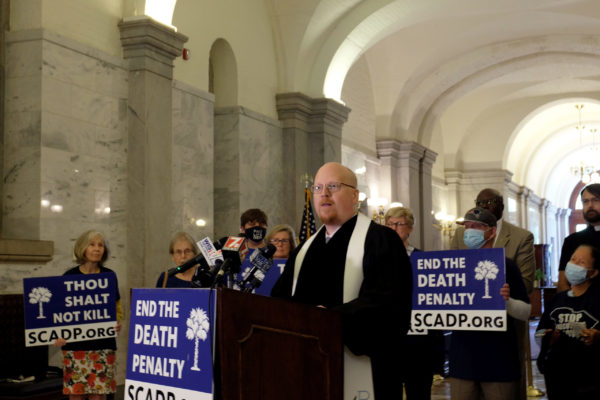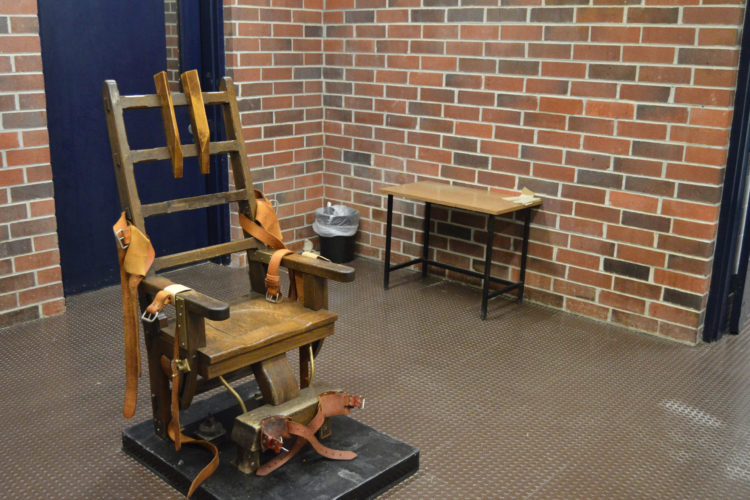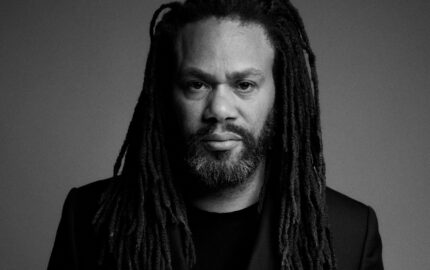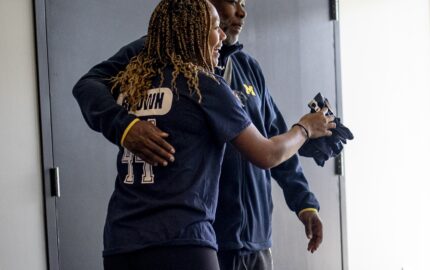In 1994, U.S. Supreme Court Justice Harry Blackmun reversed his long-held, if ambivalent, support of the constitutionality of capital punishment. In an emotional dissent, the 85-year-old justice famously called the workings of “the machinery of death.”
The death penalty has been a divisive issue since British settlers brought the practice to the Americas; the first recorded execution in the new colonies was of a convicted spy in 1608. The controversy has been tracked by stellar journalism for decades — some focused on prisoners waiting on death row, some on the forever anguish of victims’ families, some on the capriciousness of the legal system. But little has been known about the functionaries who carry out society’s final edict.

Now, thanks to dogged reporting and sensitive sourcing, investigative reporter Chiara Eisner of The State, in Columbia, South Carolina, takes readers behind the machinery doors to show the toll it takes on those who often remain in the dark: the executioners.
“Secrets of the Death Chamber” opens with an executioner reciting the Lord’s Prayer, then widens the aperture to explore the mental cost of carrying out the death penalty. Some of those profiled in Eisner’s story come to oppose the death penalty; others continue to support it. All of them add to readers’ understanding of the barbed topic of the death penalty and the costs it carries.
The story had an unusual genesis: an op-ed by a former warden that piqued journalists’ interest and 100 pages of deposition notes from a lawsuit filed by former corrections employees.
“As I read on in the (court) documents, I realized that since their claims had ultimately been dismissed, the former executioners might still be aching for a chance to feel heard,” Eisner said.
While the former executioners’ stories were deemed important for readers, Eisner said she took care with her sources and interviews: “I needed to know that this story wouldn’t just add to their pain before I could start working in earnest on it.”
Eisner described her reporting process, ethical considerations and lessons learned over e-mail with Storyboard. Her answers have been edited for length and clarity.

We don’t often hear from the people who carry out the tasks of executions. How did your story develop?
After lawmakers in South Carolina approved the firing squad in May as the state’s newest method of execution, and two people were scheduled to be executed in June, The State ran an opinion piece from a former warden who said that performing executions had been traumatic for him and the prison staff who worked with him in Florida. (Editor’s note: That piece is behind a paywall.)
That got our team thinking: What about the workers in South Carolina — how did they feel about doing the job? We knew there must have been plenty of the employees tasked with executions still alive, since the state executed 43 people from 1985 to 2011. We wanted to find and share more of their perspective with our audience, but make it local, especially as South Carolina was preparing to start executing again.
It’s hard to imagine more emotional interviews than with people who do this work. What challenges did these interviews pose, and how did you prepare for them?
I knew that if the information about the executioners’ toll became known, it would benefit the general public. That was never in question. But what about the people I would have to interview for the story? Could the reporting be done without harming them?
Before interviewing anyone, following a tip, I had already dug into court records and read more than 100 pages of deposition notes from two former executioners in South Carolina who had filed legal claims. In the records, they said they had suffered as a result of their jobs and felt some shame about their roles. The first challenge was determining that my story wouldn’t just bring more pain.
The first challenge was determining my story wouldn’t just bring more pain.
As I read on in the documents, I realized that since their claims had ultimately been dismissed, the former executioners might still be aching for a chance to feel heard. And both hinted in the records that their work on executions had changed their views about capital punishment. Some of the workers might see value in sharing their perspectives and concerns with a wider audience, perhaps more now than ever since two executions had just been scheduled in the state for the first time in a decade. With some, that hunch proved true. A few of the people I approached told me they did want to share their stories so that what happened to them wouldn’t happen again.
After I made that case to myself, I could proceed with making it to them.
While preparing for the interviews, I read these tips from journalist Marcela Turati, which I found on the website of the Dart Center for Journalism and Trauma. I wanted to be sure I wasn’t missing anything obvious or accidentally doing something harmful. Her advice was helpful.
But mostly, I stuck to basic principles that have served me well for talking with anybody. I was clear from the start about who I was and what I wanted to do, and tried to show respect, compassion and interest throughout the interviews. All of that was genuine, so I think it came through.
Please describe the general reporting and writing process.
With the help of my wonderful editor, Gina Smith, and our hard-working summer intern, Nick Sullivan, we kept looking in the court documents for names of people we wanted to interview, and also scoured archival articles the newspaper had written on previous executions. We talked to corrections sources who would have been connected to workers, asked lawyers, asked experts, and grew a list of people we thought could have been involved in capital punishment in South Carolina. We cast a wide net. It was important to collect the opinions of many different kinds of people across a spectrum of backgrounds so the article could reflect a diversity of viewpoints.
We started tackling the list first by sending emails, making phone calls, leaving voicemails and writing Facebook messages. But we didn’t have much luck. But by the summer of 2021, when I started reporting, many people in the state had been vaccinated and were more comfortable accepting home visitors, I begged my editor to let me go door-knocking and she agreed it was time.
It was the first door-knocking drive I had done since the pandemic started, and gosh, it was so effective. Not everyone opened up for me right away — I left handwritten notes tucked under doormats when they didn’t — but people started calling me back. I knew then we would be able to do the story.
It was the first door-knocking drive I had done since the pandemic started, and gosh, it was so effective.
I was eager to talk to anyone who would talk to me even if they were more tangentially involved in executions. Very little public information exists about how executions are conducted, so even when I knew I wouldn’t be quoting someone in the story, I used their interviews to corroborate information from the others that I did end up naming. And some of those conversations inspired the Freedom of Information Act requests I started to send to the S.C. Department of Corrections. Information I gained through that formed the backbone of the third article in the Secrets of the Death Chamber series, an investigation into what the South Carolina Department of Corrections was hiding from the public about its firing squad preparations and execution plans.
I ended up speaking with far more than the 10 people I mentioned directly in the story. I talked to dozens of people at least once and interviewed some of the main characters about five times each before the story was published in November. There were lots of additional fact-checking texts that my sources graciously entertained.
In August, I began compiling information from the court documents and interviews into a spreadsheet so that I could compare dates, quotes and facts quickly. My editor would ask me during that time if I had started writing yet and I had to tell her, erm, not exactly. I was “pre-writing,” and I’ll admit I think I spent a bit too much time doing it. But the spreadsheet helped me know where I wanted to go with the story and what was the best material to use. When I actually started writing, I felt more confident about the choices I was making about what to include.
And then, just a few weeks before the story was supposed to be published in October, my life outside of my job began to unravel. Pair housing insecurity and relationship issues with the intense pressure I was putting on myself to make the story as good as it needed to be, and for a moment, I found myself unable to function.
My editor encouraged me to take some time off and postponed the project’s publication so I could take a break. The final story that ran in November was better for it, and so was I.
You chose to open with a dramatic scene: Craig Baxley carrying out an execution, then fervently praying afterward in a nearby restroom. Why did you choose that scene to launch your project?
The scene accomplishes multiple things at once. First, it tells readers immediately that what they’re about to read is special. Very few intimate accounts of the experience of an executioner in the death chamber have been published. I don’t know of any that are this detailed.
Second, I wanted to make sure that even if my reader didn’t finish the story or stopped half-way through, they would still get the gist of the experience of what it’s like to carry out an execution and live with the consequences. That’s why I hinted at not only the action of the moment of his first execution, but also mentioned some of the physical and mental health struggles that he told me he has lived with since.
Mostly, though, the scene was a good candidate to open the story because Craig was generous with his time. After I started writing and had an idea that I wanted to use it there, Craig was eager to help me get my account to match his memory as closely as possible. I wouldn’t have been able to begin that way without him being so patient about reviewing details of that evening for me again and again.
You use experts, such as a theologian specializing in moral injury and, later, a psychology researcher. Why was it important to include their voices? At what point in the process did you realize you wanted to include them?
In early versions of the story, I didn’t include the experts. The article was then exclusively made up of the experiences of the execution workers. At first, I felt like that was correct because I thought, who could know more about this than the few people who had to actually carry the executions out?
But after reading that early draft, Brian Tolley, the president of The State, suggested the piece could benefit from outside commentary. He was absolutely right.
Dr. Rita Nakashima Brock, a theologian who organizes trauma support care for veterans, hadn’t worked with former executioners or execution workers when I talked to her. But she understood the situation immediately, and drew insightful parallels to the moral consequences suffered by people in the military. I think her perspective helped make the story relatable to readers who might know someone suffering from post-traumatic stress syndrome owing to their military service.
And I found Professor Emerit of Psychology Dr. Jennifer Frey’s thoughts on the issue of institutional betrayal so relevant that I used them to craft the conclusion of the article. She made it very clear when we talked that she believed governments can and should protect their workers’ health and well-being, especially when those employees are vulnerable because they have to kill others on the job.
It was a bonus that even in a story about corrections, a field dominated by men, people got to hear from two highly regarded female leaders at the top of their game. I was happy these two were the experts who agreed to interviews. They added some needed balance.
You include a paragraph about those who were unwilling to talk to you. Why?
I wanted to be honest with readers about the fact that the reason we don’t often hear from executioners isn’t only because of the secrecy that state governments tend to require. It was not easy to find people who would talk to me about their stories even after they were no longer employed by the state.
For every former execution worker who did agree to speak, there was more who preferred not to. Or they invited me into their house or took my calls, but after we spoke, they asked that our conversations and their involvement in executions be kept private.
Some gave me a reason, some didn’t. I honored their requests all the same. I understood I was asking a lot by inviting them to talk about this, so I only wanted to write about people who were aware of the risks and still eager to participate. Anything less than enthusiastic involvement could have been damaging for them in the long run.
I understood I was asking a lot by inviting them to talk about this, so I only wanted to write about people who were aware of the risks and still eager to participate.
I also used that paragraph to introduce the fact that one former executioner in South Carolina had committed suicide. Few people other than him can know for sure what led him to that decision. As I started asking questions about him, there were those who told me it was not his role as an executioner that led him to it. There were others who indicated they did think his work had played a role. I didn’t go into that in the story because I wasn’t able to ask him the question directly. Instead, I simply stated the two facts side by side: He had served as an executioner, he later committed suicide. I felt like regardless of his reason, it was important.
His experience fit in the section about the secrecy and silence of execution workers, and also allowed readers to come full circle at the end of the piece, since the first former executioner they heard from was honest about his own thoughts of suicide.
I appreciate the story’s structure, which gives each profiled person time and space to tell their story. Was that always the intended structure, or did it change during writing or editing?
That was the intended structure from the start. It became clear to me early on in my interviews that each person’s execution experience and long-term consequences, if any, were unique but related to their specific role in the killing process. I also realized that the men’s opinions today regarding capital punishment were extremely important to each of them, and slightly different. More than one person emphasized that it was critical that I not misunderstand or misrepresent that position in the article.
Organizing by occupation gave each person room while also underscoring the thesis: that their role in executions was directly related to whether they said they suffered long-term harm and moral injury afterwards. The former leaders of the prison said they were not traumatized by their executive roles in seeing the death sentences through. Executioners said they were.
If I had tried to discuss those two very different kinds of workers in the same breath, I could have risked an oversimplification that wouldn’t ring true to my sources. That was the last thing I wanted to do.
Is there anything you learned while working on this story that will help you be a better reporter in the future, or that would be helpful to other journalists?
When the story first came out, the only opinions I cared about were those of the execution workers. Even though, at first, I considered that this reporting could be beneficial to them, I didn’t do a good job of convincing myself of that. I worried I was harming the workers by asking too many questions about hard moments; I felt guilty each time I had to do it. As I was writing, I had the example of the former executioner who committed suicide very present in my mind as a worst-case scenario of what could happen if the story published and they felt it wasn’t quite right.
But as I was reporting, and after the story was published, the most wonderful thing happened: Some of the workers told me the process was actually helping them. One of them said it was affirming to read his account alongside the others, to see that he wasn’t the only one who had silently struggled with the effects of such an isolating, difficult job. Another said he was proud that family members had told him they had read his story in the article and then changed their stance on the death penalty.
That reporting could play a part in helping people heal, even from some of the worst times in their lives? I hadn’t been certain journalism held that power. I’m glad I know it does now. That was a big lesson for me.
What has reader reaction been like?
A ton of people all over the world read the story. Our numbers say almost a quarter of a million people spent considerable time with it. That’s big for a local paper. The story was picked up and shared by Apple News and The Drudge Report, which helped get it on people’s screens far outside South Carolina.
I’ve received a lot of calls and mail since. I was touched to receive a version of this email again and again: people who said they had never contacted a reporter before, but felt moved to do so this time because they wanted to thank me for telling the story fairly. Some readers wrote to express compassion for the people I interviewed, and most seemed grateful to hear the perspectives of execution workers for the first time. Lawmakers and lawyers from around the country said they, too, had never thought about this side of the death penalty, and the article had changed their perspective on capital punishment. And readers mentioned they were moved by the multimedia elements we added to the story, namely the striking photos and videos captured by Joshua Boucher, and the audio quotes we added in line with the text that allowed people to hear directly from the workers.
A few critics reached out to tell me that they thought the article should have focused instead on the trauma of the families of the victims of the people who were executed, and their comments were usually paired with a pronouncement of their continued support of the death penalty. I think it’s great those readers felt comfortable letting me know their thoughts. I hope they keep my contact information and send me story ideas in the future.
Is there anything you’re reading — fiction, journalism, anything — that you’d like to recommend?
I’m slowly reading Gabriel Garcia Marquez’s autobiography, «Vivir para contarla,» or in English, “Living to Tell the Tale.” It’s fun to hear him talk about himself. You realize he was doing that in a lot of his fiction, too.
And I just finished re-reading Rebecca Solnit’s “Hope in the Dark,” which I return to when I need a reminder of all the good that has come about as a result of people who kept fighting. I would highly recommend it to anyone who has started to feel defeated after trying to do something worthwhile but difficult. It’s a relief.



